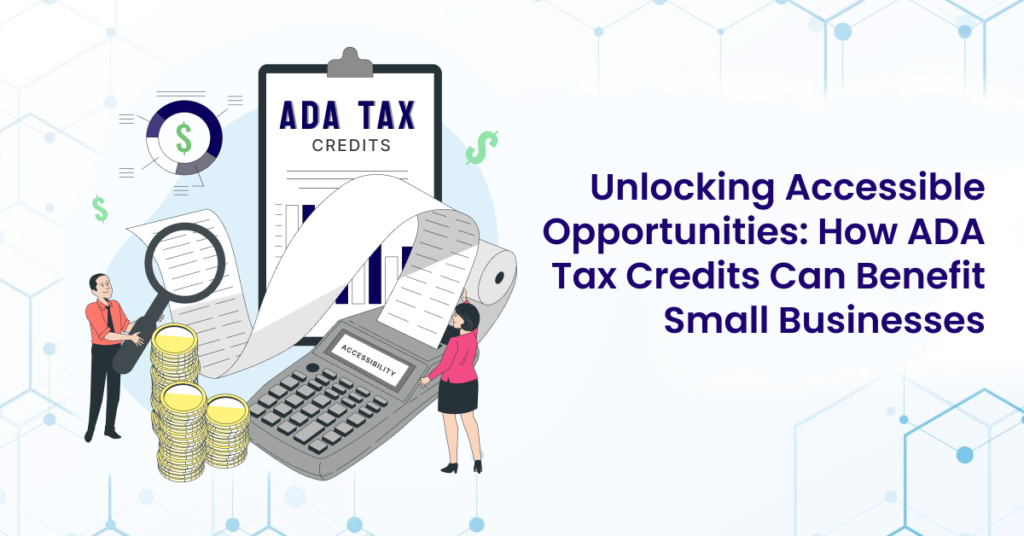Imagine you’re a small business owner in the US who’s considering investing in web accessibility. You’re well aware of how inaccessible websites can negatively impact people with disabilities, and you’re determined to make a positive change.
However, you’re facing a challenge – limited budget. The thought of justifying this expense to other stakeholders might add to your worries. You know that enhancing web accessibility is a great idea, but it seems like a costly one.
But what if there was a way to not only make your website inclusive but also financially beneficial for your business? This is exactly where the ADA Tax credits come in. Let’s explore the potential of ADA tax credits and see how they can help businesses like yours.
Understanding the ADA Tax Credit
In the world of business, where growth and profitability intersect with ethical values, the Americans with Disabilities Act (ADA) Tax Credit can provide financial incentives for companies committed to inclusivity.
The ADA Tax Credit is a form of financial incentive designed to encourage businesses to invest in accessibility solutions. It serves as a reward for companies that go the extra mile to ensure inclusivity, not only meeting legal requirements but also fostering a more accessible environment. The benefits can go up to $5000 per financial year and can be availed every year the business invests in accessibility initiatives.
Who Can Avail of ADA Tax Credits?
Businesses looking to benefit from the ADA Tax Credit should understand the eligibility criteria. The ADA Tax Credit is aimed especially at small and emerging businesses. To qualify, a business must meet the following criteria:
- Be located in the United States
- Have total revenues of $1 million or less in the previous tax year, OR
- Employ 30 or fewer full-time employees during the preceding tax year
- Compliance with ADA requirements and documented expenditure towards accessibility, like making websites accessible or providing accessible alternatives.
How Much Is the ADA Tax Credit?
Eligible businesses can claim up to 50% of qualifying expenditures, with a maximum credit of $5,000. These tax credits can be availed every year when there has been a documented expenditure towards accessibility initiatives. The credits are deducted from the net tax payable by the business. Let’s understand this through examples:
Example 1
Consider a small business that operates a retail store with an annual revenue of $900,000 and 26 full-time employees. This business decides to invest $8000 in accessibility improvements, including the installation of ramps and the enhancement of its website for better digital accessibility. Disabled Access Credit Calculation:
- Total Accessibility Expenditure: $8,000
- Subtract $250 (minimum qualifying expense) from $8,000: $7,750
- Claim 50% of $7,750 as a tax credit: $3,875
This business can claim a Disabled Access Credit of $3,875, providing a substantial financial incentive for its commitment to accessibility.
Example 2
Let’s consider another scenario where a restaurant invests $13,000 in an accessibility audit or improving its website’s accessibility and providing a braille alternative for its menus.
Since this expenditure exceeds the $10,250 limit, they can claim a maximum of $10,000. Applying the 50% tax credit to this amount results in a credit of $5,000.
How to Get the ADA Tax Credit?
Getting the ADA Tax Credit involves a systematic approach, from documentation to filing procedures. Here are some things you can keep in mind when filing for the credits:
- Maintain detailed records of expenses related to accessibility improvements.
- Provide proof of compliance with ADA requirements.
- Keep records of communication with contractors, architects, or experts regarding accessibility modifications.
Filing Procedures
Use the appropriate IRS forms, such as IRS Form 8826 for the Disabled Access Credit.
Conditions and procedures may vary, so consulting a qualified tax-skilled accountant is recommended. While pursuing the ADA Tax Credit, businesses should be mindful of common mistakes that can lead to recognition denials or complications:
Conclusion
The ADA Tax Credit represents not just a financial incentive, but a commitment to creating an inclusive environment. By understanding the nuances of eligibility, documentation, and compliance, businesses can navigate the process smoothly and ensure they receive the full benefits of the ADA Tax Credit.
While challenges may exist, the rewards extend beyond financial gains, encompassing improved customer experiences, legal protection, and an expanded market reach. As businesses strive for growth, embracing accessibility becomes a legal requirement and a strategic imperative for sustained success.
Want to start your Web Accessibility Journey? Pivotal Accessibility can help you define an effective accessibility strategy and help create a roadmap. Our Accessibility Auditors and Developers can help you reach your accessibility goals with ease. Contact us today for a free consultation.

